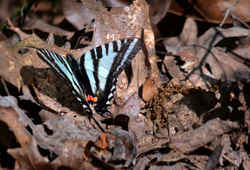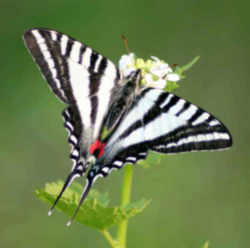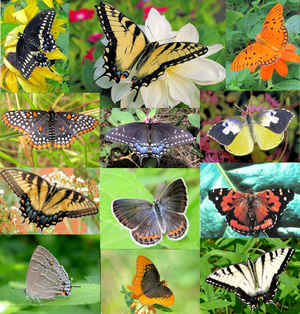
Tennessee Symbols
Tennessee State Butterfly
Zebra Swallowtail Butterfly

(Eurytides marcellus)
Adopted in 1995.
The Zebra Swallowtail, (Eurytides marcellus,) was designated as Tennessee's official butterfly by Public Chapter 896 of the 99th General Assembly in 1995. This beautiful, winged insect has black and white stripes that run the length of its body with red and blue spots on its lower back. The swallowtail grows from a tiny egg into a caterpillar that eventually molts into its pupal stage and is transformed into this striking butterfly that can be found throughout most of the United States. This butterfly was chosen by students from Gallatin mostly because it lays it's eggs in a southern favorite the PawPaw and other similar Annonaceae. This beautiful butterfly has black and white stripes that run the length of its body and is found mainly in rural areas.
Tennessee State Butterfly: Zebra Swallowtail Butterfly

The Zebra Swallowtail (Eurytides marcellus) is Tennessee's state butterfly and is found throughout the eastern U.S.
These butterflies have stripes like zebras, and tailed wings, like swallows with red and blue spots on the lower back. A striking butterfly that can be found throughout most of the United States. The caterpillars of this species eat only one kind of plant - pawpaw (Asimona spp.), and as a result this butterfly is a common sight where there are large groves of this plant. In other areas, they are spotted only occasionally, but are hard to mistake when they do appear. No other butterfly in our part of the country has the distinct black and white markings and long tails
Characteristics of the Tennessee Zebra Swallowtail
Wing span:
2 1/2 - 4 inches (6.4 - 10.4 cm). They are called swallowtails because they have long "tails" on their hindwings which look a bit like the long, pointed tails of swallows (a type of bird).
Identification:
Upper surface of wings with black stripes on pale whitish-green background; hindwings have very long tails. Early-spring form is smaller and lighter colored.
Life history:
Adult males fly in the understory near host plants to find females. Females lay single green eggs on lower leaves of host plant. Caterpillars live and feed on the underside of these leaves, then pupate and hibernate there.
Egg: A butterfly starts its life as an egg. Adult males fly in the understory near host plants to find females. Females lay single green eggs on lower leaves of host plant. Pawpaw (Asimina triloba).
Caterpillar: The larva (caterpillar) hatches from an egg and eats leaves almost constantly. It is green with one black stripe and many yellow stripes (there is also a darker form of this caterpillar which is black with yellow and white stripes). Larva eat Pawpaw (Asimina triloba). The caterpillar is pea green with yellow and black bands. They are cannibalistic. When threatened, zebra swallowtail caterpillars enlist a smelly defense: They pop out a forked orange gland, called an osmeterium, which has a pungent odor that repels small predators.
Pupa: It turns into a pupa (chrysalis); this is a resting stage. As the body transforms into a butterfly, it neither eats nor drinks. A silken girdle helps hold up the pupa. Some pupa delay emerging and overwinter before emerging.
Adult: A flying adult emerges. There is no growth during this stage, but the butterfly will sip nectar. This adult will continue the cycle by reproducing. It has a wingspan of 3.75-4.5 inches (9.5-11.5 cm). The Zebra Swallowtail lives for about 6 months in its adult stage. Adults who emerge during the spring are smaller, paler, and have shorter tails than later broods. Summer broods are larger and darker than the spring broods. Late autumn (October) broods are even larger and darker than the other broods.
Flight: Two flights, April-August, in the northern part of its range; many flights, March-December, in the south.
Adult food:
Moisture from sand and nectar from flowers including blueberry, blackberry, lilac, redbud, viper's bugloss, verbena, dogbane, and common milkweed.
Habitat:
Breeds in moist low woodlands near swamps and rivers. Adults fly to nectar plants in open fields and brushy areas.
Distribution
The zebra swallowtail is widely distributed from southern New England west to southern Minnesota and south to eastern Texas and Florida.
Tennessee Law
The law designating the zebra swallowtail as the official Tennessee state butterfly is found in the Tennessee Code Annotated, title 4, chapter 1, part 3, section 4 -1-319
TITLE 4. STATE GOVERNMENT.
CHAPTER 1. GENERAL PROVISIONS.
PART 3. STATE SYMBOLS.
4-1-319. State butterfly.
The beautiful zebra swallowtail, Eurytides marcellus, is hereby designated as the official state butterfly.
[Acts 1994, ch. 896, § 1.]
Taxonomic Hierarchy: Zebra Swallowtail Butterfly
Kingdom: Animalia (Animals)
Phylum: Arthropoda (Arthropods)
Subphylum: Hexapoda (Hexapods)
Class: Insecta (Insects)
Order: Lepidoptera (Butterflies and Moths)
Superfamily: Papilionoidea (Butterflies and Skippers)
Family: Papilionidae (Swallowtails, Parnassians)
Subfamily: Papilioninae
Tribe: Leptocircini (Kite Swallowtails, Swordtails, Jays)
Genus: Eurytides (Kite Swallowtails)
Species; marcellus (Zebra Swallowtail)
Butterflies, and Bugs







